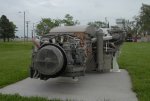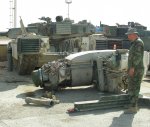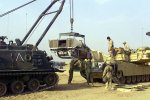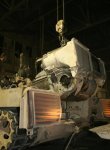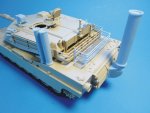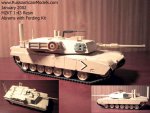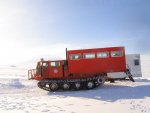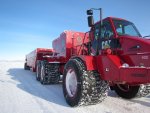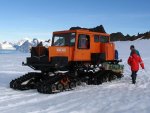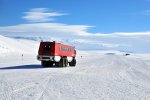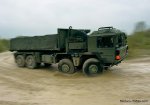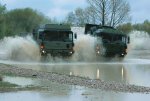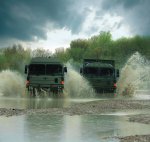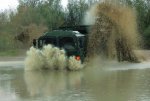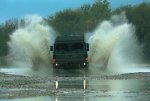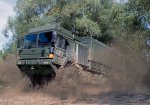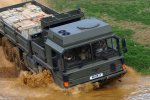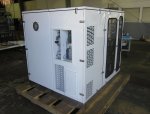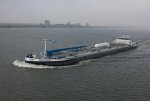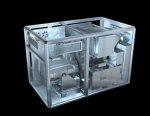biotect
Designer
.
CONTINUED FROM PREVIOUS POST
**************************************
I. Turbines and Multi-Fuel Capability
**************************************
However, with all that said, again I cannot thank you enough dwh, for broaching the topic of microturbines. They have some distinct advantages that make them worthy of serious consideration as range-extenders in hybrid expedition motorhomes.
In popular imagination, jets used in automotive applications conjure up images of cars trying to break the sound-barrier in the desert – see http://en.wikipedia.org/wiki/Jet_car . But at a more mundane level, turbine engines have long been used in boats, locomotives, and tanks, and it's worth asking why. See http://en.wikipedia.org/wiki/Gas_turbine , http://en.wikipedia.org/wiki/Gas_turbine#Marine_applications , http://en.wikipedia.org/wiki/Gas_turbine-electric_locomotive , and http://en.wikipedia.org/wiki/Gas_turbine#Tanks .
To begin with, in terms of power-to-weight performance, turbines outclass conventional diesel engines: they are lighter and smaller than equivalent horsepower diesels. Which is why the U.S. Navy ships, for instance, tend to be powered by gas-turbines – see http://www.geaviation.com/marine/engines/military/lm2500/ . But it's not just lighter weight that makes turbines attractive. They are also attractive because they can be multi-fuel.
Multi-fuel capability matters to overlanders in particular, because by definition, an overlander is someone who takes a vehicle on a journey across multiple countries, multiple continents, and multiple "fuel regimes", i.e. regions where certain kinds and qualities of fuel tend to predominate. Whenever RTW expedition vehicles are discussed on ExPo, the problem of fuel quality comes up again and again. And so too in this thread. Fuel quality is increasingly troublesome, because new trucks sold in the First World will have the latest engines designed to cut down on emissions, engines that use ultra-low-sulphur diesel (ULSD) not yet widely available in the Third World -- see http://en.wikipedia.org/wiki/Ultra-low-sulfur_diesel . If one frequently uses high-sulfur diesel in a brand-new Euro VI engine, one will probably damage the engine -- see http://www.trucknetuk.com/phpBB/view...p?f=4&t=105341 and http://www.diyforums.net/high-sulphur-diesel-in-new-model-car-440378.html .
Apparently in Third World countries where only high-sulfur diesel is available, new imported ULSD engines are sometimes fitted with Hydrogen kits to solve the problem -- http://www.greencarcongress.com/2005/11/hydrogenenhance.html , http://archive.wired.com/cars/energy/news/2005/11/69529 , http://www.marzindustries.com/index.html , http://www.hydrogen-generators-usa.com/hydrogen-generator.html , http://www.hhomart.com/category.php?id_category=2 , and http://hydroxsystems.co.uk/hho-hydr...-cell-generator-cars-vans-hydrox-systems.html . But Hydrogen Fuel Enhancement is controversial, and the claimed benefits of adding Hydrogen to improve milage, and/or resolve fuel-engine incompatibility, should probably be met with some skepticism -- see http://www.popularmechanics.com/cars/alternative-fuel/gas-mileage/4310717 , http://www.popularmechanics.com/cars/alternative-fuel/gas-mileage/4310717-2 , http://www.popularmechanics.com/cars/alternative-fuel/gas-mileage/4271579 , and http://www.popularmechanics.com/cars/alternative-fuel/gas-mileage/1802932 . The real irony here is that supposedly "clean ULSD diesel" is not that clean -- see http://www.hybridcars.com/will-america-avoid-europes-clean-diesel-problems/ .
Now a hybrid expedition vehicle equipped with a microturbine range-extender could potentially cut through this gordian knot, enabling an overlander to fill up with just about any fuel available, anywhere. An overlander driving a vehicle equipped with microturbines could fill up with low-moisure JP-5 or AN-8 when traveling in the coldest parts of Canada, Alaska, or Siberia. Then switch to local low-quality diesel when traversing the Altiplano in Bolivia. Elsewhere, such a vehicle could go "green", filling up with Biodiesel. In effect, microturbines would give such a hybrid vehicle the fuel-flexibility of an M1A2 Abrams' tank, whose AGT1500 turboshaft is designed to run on just about any type of fuel.
**************************************
J. Automotive Turbine: the precedent of the M1A1 Abrams Tank
**************************************
The M1A2 Abrams is without a doubt the most famous automotive application of turbine technology – see http://en.wikipedia.org/wiki/Gas_turbine#Tanks , http://en.wikipedia.org/wiki/M1_Abrams , http://www.fprado.com/armorsite/abrams.htm , http://science.howstuffworks.com/m1-tank2.htm , http://www.military-today.com/tanks/m1a1_abrams.htm , http://www.army-guide.com/eng/product1780.html , http://www.army.gov.au/Our-work/Equipment-and-clothing/Vehicles/M1-Abrams-tank , http://www.militaryfactory.com/armor/detail.asp?armor_id=1 , and http://defense.about.com/od/weaponry/ss/Abrams-M1-Tank.htm#step-heading .
Many suggest that the Abrams was designed around its unique engine, and at present the Abrams is the only mass-produced turbine-powered land vehicle in the world. For that reason alone, the Abrams seems worth discussing a bit, given that the current sub-topic of the thread is microturbines.
There is a particularly good description of the Abrams AGT1500 turboshaft engine at http://cset.mnsu.edu/engagethermo/systems_tank.html . The AGT1500, made by Honeywell, is a modified version of the turbine originally used to power the Cobra helicopter; it produces 1500 HP, and has an exhaust temperature of 1100 Fahrenheit. For more information, see http://en.wikipedia.org/wiki/Honeywell_AGT1500 , http://aerospace.honeywell.com/defense/platforms/m1-abrams-tank , http://www.honeywell.com/sites/serv...t?docid=DBFF4ECEE-AF8F-8ABE-F6D2-0E2E8F6A88FB , http://www51.honeywell.com/aero/com...SurfaceSystems/AGT1500_Turbine_Technology.pdf , http://turbotrain.net/en/m1tank.htm , http://wryedge.com/portfolio/agt1500-engine/ , http://www.turbokart.com/about_agt1500.htm , http://www.turbokart.com/gasturbine.htm , http://www.aoi.com.eg/aoieng/military/overhaul/overhaul.html , and http://transupport.com .
Here are some images:

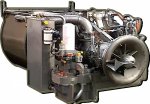



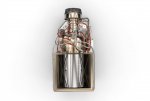


The first video below includes lots of descriptive visualizations of the AGT1500, while the second is an animated cutaway from Honeywell, indicating where the turbine sits in the Abrams tank:
[video=youtube;7Zc8dVGqTUI]https://www.youtube.com/watch?v=7Zc8dVGqTUI [/video]
**************************************
J. Abrams Air-Intake/Exhaust
**************************************
It's important to remember that the turboshaft engine is just the "core" of the Abrams' power pack, which is much larger, and includes massive fans for sucking in air:

Furthermore, as near as I can tell, the Honeywell video is not very accurate, because it shows the turbine mounted transversally. Whereas almost all other imagery on the web, both video and still, suggests that the Abrams turbine is mounted lengthwise, as per this very useful cutaway drawing:

Here are two videos of the Abrams having its powerpack pulled, which suggest the same:
[video=youtube;Sw0R_jAKGrE]https://www.youtube.com/watch?v=Sw0R_jAKGrE [/video]
**************************************
CONTINUED IN NEXT POST
.
CONTINUED FROM PREVIOUS POST
**************************************
I. Turbines and Multi-Fuel Capability
**************************************
However, with all that said, again I cannot thank you enough dwh, for broaching the topic of microturbines. They have some distinct advantages that make them worthy of serious consideration as range-extenders in hybrid expedition motorhomes.
In popular imagination, jets used in automotive applications conjure up images of cars trying to break the sound-barrier in the desert – see http://en.wikipedia.org/wiki/Jet_car . But at a more mundane level, turbine engines have long been used in boats, locomotives, and tanks, and it's worth asking why. See http://en.wikipedia.org/wiki/Gas_turbine , http://en.wikipedia.org/wiki/Gas_turbine#Marine_applications , http://en.wikipedia.org/wiki/Gas_turbine-electric_locomotive , and http://en.wikipedia.org/wiki/Gas_turbine#Tanks .
To begin with, in terms of power-to-weight performance, turbines outclass conventional diesel engines: they are lighter and smaller than equivalent horsepower diesels. Which is why the U.S. Navy ships, for instance, tend to be powered by gas-turbines – see http://www.geaviation.com/marine/engines/military/lm2500/ . But it's not just lighter weight that makes turbines attractive. They are also attractive because they can be multi-fuel.
Multi-fuel capability matters to overlanders in particular, because by definition, an overlander is someone who takes a vehicle on a journey across multiple countries, multiple continents, and multiple "fuel regimes", i.e. regions where certain kinds and qualities of fuel tend to predominate. Whenever RTW expedition vehicles are discussed on ExPo, the problem of fuel quality comes up again and again. And so too in this thread. Fuel quality is increasingly troublesome, because new trucks sold in the First World will have the latest engines designed to cut down on emissions, engines that use ultra-low-sulphur diesel (ULSD) not yet widely available in the Third World -- see http://en.wikipedia.org/wiki/Ultra-low-sulfur_diesel . If one frequently uses high-sulfur diesel in a brand-new Euro VI engine, one will probably damage the engine -- see http://www.trucknetuk.com/phpBB/view...p?f=4&t=105341 and http://www.diyforums.net/high-sulphur-diesel-in-new-model-car-440378.html .
Apparently in Third World countries where only high-sulfur diesel is available, new imported ULSD engines are sometimes fitted with Hydrogen kits to solve the problem -- http://www.greencarcongress.com/2005/11/hydrogenenhance.html , http://archive.wired.com/cars/energy/news/2005/11/69529 , http://www.marzindustries.com/index.html , http://www.hydrogen-generators-usa.com/hydrogen-generator.html , http://www.hhomart.com/category.php?id_category=2 , and http://hydroxsystems.co.uk/hho-hydr...-cell-generator-cars-vans-hydrox-systems.html . But Hydrogen Fuel Enhancement is controversial, and the claimed benefits of adding Hydrogen to improve milage, and/or resolve fuel-engine incompatibility, should probably be met with some skepticism -- see http://www.popularmechanics.com/cars/alternative-fuel/gas-mileage/4310717 , http://www.popularmechanics.com/cars/alternative-fuel/gas-mileage/4310717-2 , http://www.popularmechanics.com/cars/alternative-fuel/gas-mileage/4271579 , and http://www.popularmechanics.com/cars/alternative-fuel/gas-mileage/1802932 . The real irony here is that supposedly "clean ULSD diesel" is not that clean -- see http://www.hybridcars.com/will-america-avoid-europes-clean-diesel-problems/ .
Now a hybrid expedition vehicle equipped with a microturbine range-extender could potentially cut through this gordian knot, enabling an overlander to fill up with just about any fuel available, anywhere. An overlander driving a vehicle equipped with microturbines could fill up with low-moisure JP-5 or AN-8 when traveling in the coldest parts of Canada, Alaska, or Siberia. Then switch to local low-quality diesel when traversing the Altiplano in Bolivia. Elsewhere, such a vehicle could go "green", filling up with Biodiesel. In effect, microturbines would give such a hybrid vehicle the fuel-flexibility of an M1A2 Abrams' tank, whose AGT1500 turboshaft is designed to run on just about any type of fuel.
**************************************
J. Automotive Turbine: the precedent of the M1A1 Abrams Tank
**************************************
The M1A2 Abrams is without a doubt the most famous automotive application of turbine technology – see http://en.wikipedia.org/wiki/Gas_turbine#Tanks , http://en.wikipedia.org/wiki/M1_Abrams , http://www.fprado.com/armorsite/abrams.htm , http://science.howstuffworks.com/m1-tank2.htm , http://www.military-today.com/tanks/m1a1_abrams.htm , http://www.army-guide.com/eng/product1780.html , http://www.army.gov.au/Our-work/Equipment-and-clothing/Vehicles/M1-Abrams-tank , http://www.militaryfactory.com/armor/detail.asp?armor_id=1 , and http://defense.about.com/od/weaponry/ss/Abrams-M1-Tank.htm#step-heading .
Many suggest that the Abrams was designed around its unique engine, and at present the Abrams is the only mass-produced turbine-powered land vehicle in the world. For that reason alone, the Abrams seems worth discussing a bit, given that the current sub-topic of the thread is microturbines.
There is a particularly good description of the Abrams AGT1500 turboshaft engine at http://cset.mnsu.edu/engagethermo/systems_tank.html . The AGT1500, made by Honeywell, is a modified version of the turbine originally used to power the Cobra helicopter; it produces 1500 HP, and has an exhaust temperature of 1100 Fahrenheit. For more information, see http://en.wikipedia.org/wiki/Honeywell_AGT1500 , http://aerospace.honeywell.com/defense/platforms/m1-abrams-tank , http://www.honeywell.com/sites/serv...t?docid=DBFF4ECEE-AF8F-8ABE-F6D2-0E2E8F6A88FB , http://www51.honeywell.com/aero/com...SurfaceSystems/AGT1500_Turbine_Technology.pdf , http://turbotrain.net/en/m1tank.htm , http://wryedge.com/portfolio/agt1500-engine/ , http://www.turbokart.com/about_agt1500.htm , http://www.turbokart.com/gasturbine.htm , http://www.aoi.com.eg/aoieng/military/overhaul/overhaul.html , and http://transupport.com .
Here are some images:








The first video below includes lots of descriptive visualizations of the AGT1500, while the second is an animated cutaway from Honeywell, indicating where the turbine sits in the Abrams tank:
[video=youtube;7Zc8dVGqTUI]https://www.youtube.com/watch?v=7Zc8dVGqTUI [/video]
**************************************
J. Abrams Air-Intake/Exhaust
**************************************
It's important to remember that the turboshaft engine is just the "core" of the Abrams' power pack, which is much larger, and includes massive fans for sucking in air:

Furthermore, as near as I can tell, the Honeywell video is not very accurate, because it shows the turbine mounted transversally. Whereas almost all other imagery on the web, both video and still, suggests that the Abrams turbine is mounted lengthwise, as per this very useful cutaway drawing:

Here are two videos of the Abrams having its powerpack pulled, which suggest the same:
[video=youtube;Sw0R_jAKGrE]https://www.youtube.com/watch?v=Sw0R_jAKGrE [/video]
**************************************
CONTINUED IN NEXT POST
.
Last edited:

